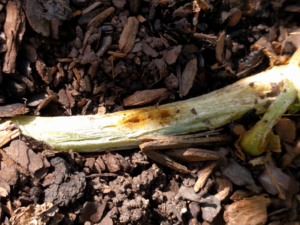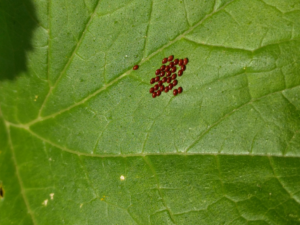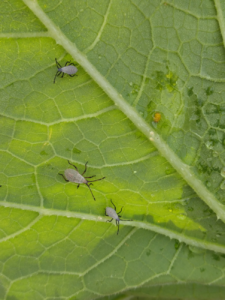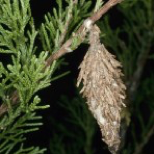Dealing With Squash Bugs?
go.ncsu.edu/readext?709863
en Español / em Português
El inglés es el idioma de control de esta página. En la medida en que haya algún conflicto entre la traducción al inglés y la traducción, el inglés prevalece.
Al hacer clic en el enlace de traducción se activa un servicio de traducción gratuito para convertir la página al español. Al igual que con cualquier traducción por Internet, la conversión no es sensible al contexto y puede que no traduzca el texto en su significado original. NC State Extension no garantiza la exactitud del texto traducido. Por favor, tenga en cuenta que algunas aplicaciones y/o servicios pueden no funcionar como se espera cuando se traducen.
Português
Inglês é o idioma de controle desta página. Na medida que haja algum conflito entre o texto original em Inglês e a tradução, o Inglês prevalece.
Ao clicar no link de tradução, um serviço gratuito de tradução será ativado para converter a página para o Português. Como em qualquer tradução pela internet, a conversão não é sensivel ao contexto e pode não ocorrer a tradução para o significado orginal. O serviço de Extensão da Carolina do Norte (NC State Extension) não garante a exatidão do texto traduzido. Por favor, observe que algumas funções ou serviços podem não funcionar como esperado após a tradução.
English
English is the controlling language of this page. To the extent there is any conflict between the English text and the translation, English controls.
Clicking on the translation link activates a free translation service to convert the page to Spanish. As with any Internet translation, the conversion is not context-sensitive and may not translate the text to its original meaning. NC State Extension does not guarantee the accuracy of the translated text. Please note that some applications and/or services may not function as expected when translated.
Collapse ▲Summer is in full swing and after an inconsistent spring, the weather seems to have settled down to typical summer weather – hot, humid, and occasional rain. Vegetable plants that were knocked back by the late frost in May should be starting to catch up on growth now. The biggest chores in the vegetable garden will probably be watering and scouting for pests and diseases.
Common Squash Pests
Squash Vine Borers, Squash Bugs, & Squash Beetles
Squash plants, and their relative’s cucumbers and melons, draw a large share of the pests. Three of the most common pests on squash plants this time of year are squash vine borers, squash bugs, and squash beetles.
You may never see the squash vine borer itself. What you will probably see is what looks like a long slit in the stem near the soil line, often accompanied by a small pile of what looks like sawdust (Figure 1).

Figure 1
The borer is inside the stem of the plant, making its way through the stem to the crown of the plant. If you notice the damage early enough, you can cut a slit in the plant and remove the borer. If the borer continues, over time affected plants may wilt and eventually die. You can control the insect by keeping a row cover over plants until they bloom. This will prevent the adult form of the borer, a clear-wing moth, from laying eggs on the plants. You can also plant resistant varieties, such as yellow crookneck squash. Be sure to rotate squash to another area in the garden for the next year, as the larvae of the squash vine borer pupates in the soil and will emerge as an adult moth.
Squash bug adults are noticeable in the garden now. But to get ahead of this pest, you need to scout for the eggs and the nymphs. Eggs are bronze-colored and will be in clusters on tops and bottoms of leaves (Figure 2).

Figure 2
Once the eggs hatch, the small cream-colored nymphs start feeding (Figure 3). Both the nymphs and the adult squash bugs insert toxins into plants as they feed, causing vines to dry out and turn black. The easiest way to control squash bugs in any life stage is to remove them from the plant and either squash them or drop them into a bucket of soapy water. Remove eggs when you find them and crush them. Rotate squash and melons to a different area in the garden each year as the adults overwinter in the soil and will emerge to start feeding and laying eggs.

Figure 3
One additional pest of squash that you might see is the squash beetle (Figure 4). At first glance, you might think it is a ladybug. Although the squash beetle is related to ladybugs, it is not beneficial but a pest of squash, cucumbers, melons, and pumpkins.

Figure 4
Feeding by the insects will skeletonize leaves. Look for yellow eggs that the squash beetle lays on the undersides of leaves (Figure 5). The eggs will hatch out into yellow nymphs with black bristles. Nymphs feed on leaves, while adults feed on both leaves and fruit. The best way to control squash beetles is to remove them and drop them into a bucket of soapy water. Nymphs are easily crushed. Remove any eggs you find.

Figure 5
Other Garden Pests
Potato Aphids
Although tomatoes have their fair share of pests and other problems, one pest which might remain unnoticeable until it has done a lot of damage is the potato aphid (Figure 6). Potato aphids are usually red or dark pink. You will find them on the underside of the leaf. Potato aphids feed by sucking juices from the tomato leaves. Large populations of the pests and heavy feeding will remove enough sap from the leaves to cause them to curl. Control potato aphids by spraying with insecticidal soap.

Figure 6
Bagworm
In the landscape, a common problem on arborvitae, Leyland cypress, and juniper this time of year is the bagworm. Bagworms are different from many other caterpillars in that they construct and carry their own home with them. Bagworm larvae hatch in June and immediately start feeding on plants. As they feed and grow, they construct a brown cone-shaped bag to protect them (Figure 7). When you see these bags on a conifer, you might think they are little pine cones. However, unlike pine cones, you might see them move.
Bagworm larvae feed during the summer, then attach the bag to the tree where they are feeding. Once the bag is attached, they pupate. Female bagworms lay their eggs in the bag. Larva will hatch out inside the bag the next year, during late spring or early summer, and the cycle continues.
Heavy feeding by bagworms can defoliate trees, weakening, or even killing the trees. Bagworms can be cut off the trees, but this method of control is impractical for large trees or heavy infestations. Chemical control is only effective when the bagworms are actively feeding and before they enter the bags to pupate. Bagworms can be controlled with pesticides containing bifenthrin, azadirachtin, permethrin, or spinosad. Bagworms can also be controlled with B.t., but this is only effective when the larvae are very small.

Figure 7




